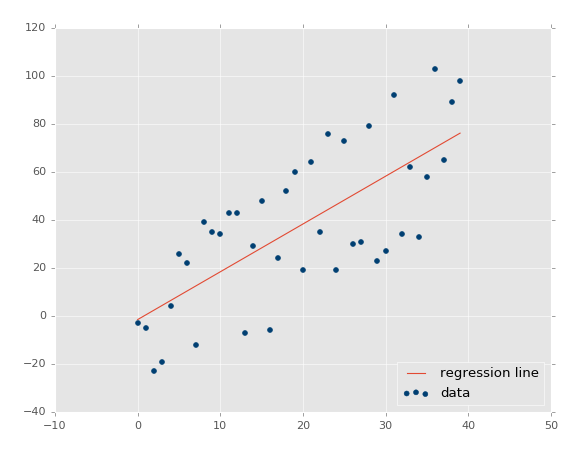A Beginner’s Guide to Linear Regression in Python with Scikit-Learn
What linear regression is and how it can be implemented for both two variables and multiple variables using Scikit-Learn, which is one of the most popular machine learning libraries for Python.
There are two types of supervised machine learning algorithms: Regression and classification. The former predicts continuous value outputs while the latter predicts discrete outputs. For instance, predicting the price of a house in dollars is a regression problem whereas predicting whether a tumor is malignant or benign is a classification problem.
In this article, we will briefly study what linear regression is and how it can be implemented for both two variables and multiple variables using Scikit-Learn, which is one of the most popular machine learning libraries for Python.
Linear Regression Theory
The term “linearity” in algebra refers to a linear relationship between two or more variables. If we draw this relationship in a two-dimensional space (between two variables), we get a straight line.
Linear regression performs the task to predict a dependent variable value (y) based on a given independent variable (x). So, this regression technique finds out a linear relationship between x (input) and y(output). Hence, the name is Linear Regression. If we plot the independent variable (x) on the x-axis and dependent variable (y) on the y-axis, linear regression gives us a straight line that best fits the data points, as shown in the figure below.
We know that the equation of a straight line is basically:
The equation of the above line is :
Y= mx + b
Where b is the intercept and m is the slope of the line. So basically, the linear regression algorithm gives us the most optimal value for the intercept and the slope (in two dimensions). The y and x variables remain the same, since they are the data features and cannot be changed. The values that we can control are the intercept(b) and slope(m). There can be multiple straight lines depending upon the values of intercept and slope. Basically what the linear regression algorithm does is it fits multiple lines on the data points and returns the line that results in the least error.
This same concept can be extended to cases where there are more than two variables. This is called multiple linear regression. For instance, consider a scenario where you have to predict the price of the house based upon its area, number of bedrooms, the average income of the people in the area, the age of the house, and so on. In this case, the dependent variable(target variable) is dependent upon several independent variables. A regression model involving multiple variables can be represented as:
y = b0 + m1b1 + m2b2 + m3b3 + ... mnbn
This is the equation of a hyperplane. Remember, a linear regression model in two dimensions is a straight line; in three dimensions it is a plane, and in more than three dimensions, a hyperplane.
In this section, we will see how Python’s Scikit-Learn library for machine learning can be used to implement regression functions. We will start with simple linear regression involving two variables and then we will move towards linear regression involving multiple variables.
Simple Linear Regression
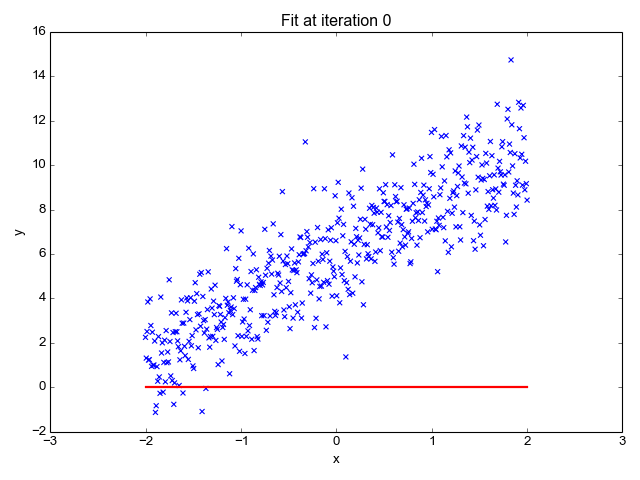
While exploring the Aerial Bombing Operations of World War Two dataset and recalling that the D-Day landings were nearly postponed due to poor weather, I downloaded these weather reports from the period to compare with missions in the bombing operations dataset.
You can download the dataset from here.
The dataset contains information on weather conditions recorded on each day at various weather stations around the world. Information includes precipitation, snowfall, temperatures, wind speed and whether the day included thunderstorms or other poor weather conditions.
So our task is to predict the maximum temperature taking input feature as minimum temperature.
Let's start coding :
Import all the required libraries :
import pandas as pd import numpy as np import matplotlib.pyplot as plt import seaborn as seabornInstance from sklearn.model_selection import train_test_split from sklearn.linear_model import LinearRegression from sklearn import metrics %matplotlib inline
The following command imports the CSV dataset using pandas:
dataset = pd.read_csv('/Users/nageshsinghchauhan/Documents/projects/ML/ML_BLOG_LInearRegression/Weather.csv')
Let’s explore the data a little bit by checking the number of rows and columns in our datasets.
dataset.shape
You should receive output as (119040, 31), which means the data contains 119040 rows and 31 columns.
To see the statistical details of the dataset, we can use describe():
dataset.describe()

And finally, let’s plot our data points on a 2-D graph to eyeball our dataset and see if we can manually find any relationship between the data using the below script :
dataset.plot(x='MinTemp', y='MaxTemp', style='o')
plt.title('MinTemp vs MaxTemp')
plt.xlabel('MinTemp')
plt.ylabel('MaxTemp')
plt.show()
We have taken MinTemp and MaxTemp for doing our analysis. Below is a 2-D graph between MinTemp and MaxTemp.

Let’s check the average max temperature and once we plot it we can observe that the Average Maximum Temperature is Between Nearly 25 and 35.
plt.figure(figsize=(15,10)) plt.tight_layout() seabornInstance.distplot(dataset['MaxTemp'])

Our next step is to divide the data into “attributes” and “labels”.
Attributes are the independent variables while labels are dependent variables whose values are to be predicted. In our dataset, we only have two columns. We want to predict the MaxTemp depending upon the MinTemp recorded. Therefore our attribute set will consist of the “MinTemp” column which is stored in the X variable, and the label will be the “MaxTemp” column which is stored in y variable.
X = dataset['MinTemp'].values.reshape(-1,1) y = dataset['MaxTemp'].values.reshape(-1,1)
Next, we split 80% of the data to the training set while 20% of the data to test set using below code.
The test_size variable is where we actually specify the proportion of the test set.
X_train, X_test, y_train, y_test = train_test_split(X, y, test_size=0.2, random_state=0)
After splitting the data into training and testing sets, finally, the time is to train our algorithm. For that, we need to import LinearRegression class, instantiate it, and call the fit() method along with our training data.
regressor = LinearRegression() regressor.fit(X_train, y_train) #training the algorithm
As we have discussed that the linear regression model basically finds the best value for the intercept and slope, which results in a line that best fits the data. To see the value of the intercept and slop calculated by the linear regression algorithm for our dataset, execute the following code.
#To retrieve the intercept: print(regressor.intercept_) #For retrieving the slope: print(regressor.coef_)
The result should be approximately 10.66185201 and 0.92033997 respectively.
This means that for every one unit of change in Min temperature, the change in the Max temperature is about 0.92%.
Now that we have trained our algorithm, it’s time to make some predictions. To do so, we will use our test data and see how accurately our algorithm predicts the percentage score. To make predictions on the test data, execute the following script:
y_pred = regressor.predict(X_test)
Now compare the actual output values for X_test with the predicted values, execute the following script:
df = pd.DataFrame({'Actual': y_test.flatten(), 'Predicted': y_pred.flatten()})
df
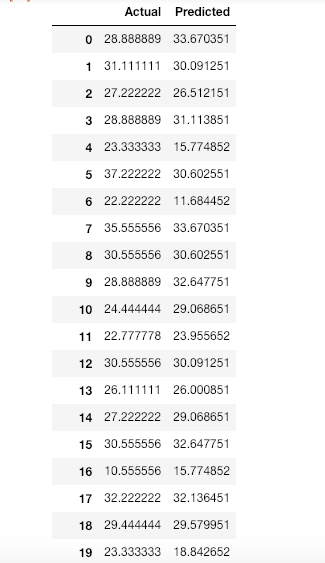
We can also visualize comparison result as a bar graph using the below script :
Note: As the number of records is huge, for representation purpose I’m taking just 25 records.
df1 = df.head(25) df1.plot(kind='bar',figsize=(16,10)) plt.grid(which='major', linestyle='-', linewidth='0.5', color='green') plt.grid(which='minor', linestyle=':', linewidth='0.5', color='black') plt.show()
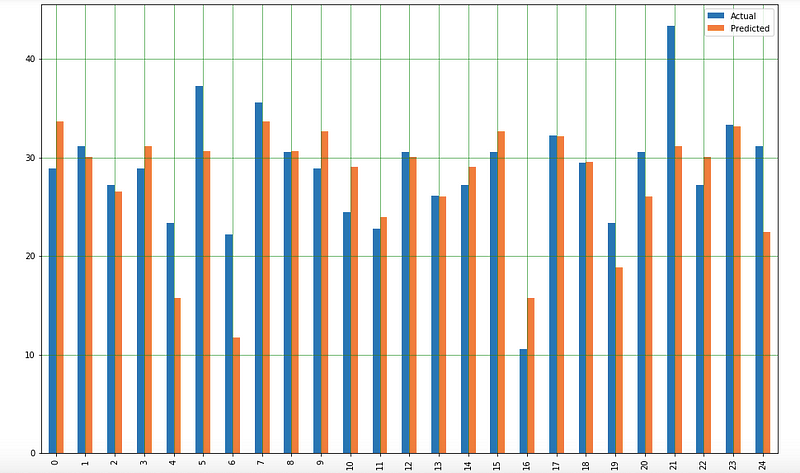
Though our model is not very precise, the predicted percentages are close to the actual ones.
Let's plot our straight line with the test data :
plt.scatter(X_test, y_test, color='gray') plt.plot(X_test, y_pred, color='red', linewidth=2) plt.show()
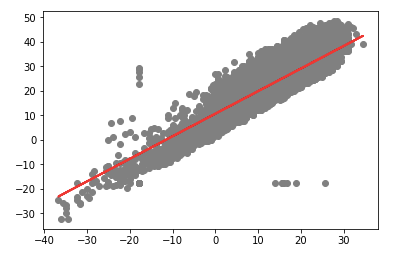
The straight line in the above graph shows our algorithm is correct.
The final step is to evaluate the performance of the algorithm. This step is particularly important to compare how well different algorithms perform on a particular dataset. For regression algorithms, three evaluation metrics are commonly used:
1. Mean Absolute Error (MAE) is the mean of the absolute value of the errors. It is calculated as:

2. Mean Squared Error (MSE) is the mean of the squared errors and is calculated as:
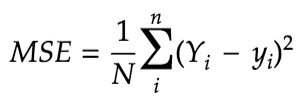
3. Root Mean Squared Error (RMSE) is the square root of the mean of the squared errors:

Luckily, we don’t have to perform these calculations manually. The Scikit-Learn library comes with pre-built functions that can be used to find out these values for us.
Let’s find the values for these metrics using our test data.
print('Mean Absolute Error:', metrics.mean_absolute_error(y_test, y_pred))
print('Mean Squared Error:', metrics.mean_squared_error(y_test, y_pred))
print('Root Mean Squared Error:', np.sqrt(metrics.mean_squared_error(y_test, y_pred)))
You should receive output like this (but probably slightly different):
('Mean Absolute Error:', 3.19932917837853)
('Mean Squared Error:', 17.631568097568447)
('Root Mean Squared Error:', 4.198996082109204)
You can see that the value of root mean squared error is 4.19, which is more than 10% of the mean value of the percentages of all the temperature i.e. 22.41. This means that our algorithm was not very accurate but can still make reasonably good predictions.


